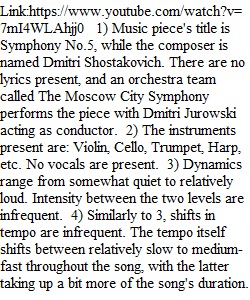


Q Choose one (1) of the following links, listen to it, and respond to these questions. You should listen to the selection more than once. The information from these listening journal entries will be used to write the content for your final essay. I'd like all of you to do well on the final essay, so these listening journal entries will be graded as "incomplete" or "complete." If I have marked yours as "incomplete," take a look at the comments I've made and fix the things I've addressed in the comments, then resubmit. Title: Symphony No. 5 Composer: Dmitri Shostakovich Performed by: The Moscow City Symphony, conducted by Dmitri Jurowski https://www.youtube.com/watch?v=7mI4WLAhjj0Links to an external site. Title: Lyric for Strings Composer: George T. Walker (Pulitzer Prize winner for music with Lilacs for Voice and Orchestra in 1996, the first African American composer to win) Performed by: Chineke! Orchestra, conducted by Kevin John Eduseihttps://www.youtube.com/watch?v=gZLLVacAT6YLinks to an external site. Title: Early Light Composer: Carolyn Bremer Performed by: The Bob Cole Conservatory Symphonic Band, conducted by Jermie S. Arnold Early Light - Carolyn BremerLinks to an external site. Title: O Superman Composer: Laurie Anderson Performed by: Laurie Anderson Laurie Anderson - O Superman [Official Music Video]Links to an external site. 1. What is the title of the piece of music? Who is the composer (who wrote the music)? If this is an example of popular music and there are lyrics, who wrote the lyrics? Who is performing the piece of music? 2. This question refers to timbre (the what and who in music making). What instruments do you hear/see? Are there vocals? If so, what voice types do you hear (list the gender(s) or be more specific, e.g. sopranos/altos, tenors, basses, etc.)? 3. This question refers to dynamics (levels of loudness). What is the intensity of volume (loudness) of the music? Does the intensity ever change? Does it change often or infrequently? 4. This question refers to tempo (the pace of the music). How fast is the music moving? Does the pace of the music ever change? Does it change often or infrequently? You can show off your music vocabulary by using the Italian terms for tempo that you will find on the vocabulary list or put it in your own words by using “relatively fast,” “slow,” or “medium pace,” etc. 5. This question refers to your emotional response to the music. What does the music make you feel? What does the music remind you of? 6. This question will help you when you’re writing your final essay, “Desert Island Music.” Is there an activity that you can think of that would work with this piece of music? For example, if it’s fast and energetic, maybe you could imagine listening to it while chopping wood for your bonfire. If it’s slower, maybe it’s what you could imagine listening to while trying to sleep at night. Be creative.
View Related Questions